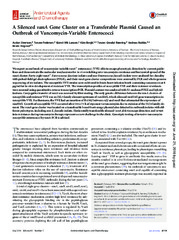Silenced vanA gene cluster on a transferable plasmid cause outbreak of vancomycin variable enterococci
Permanent link
https://hdl.handle.net/10037/10479Date
2016-05-02Type
Journal articleTidsskriftartikkel
Peer reviewed
Author
Sivertsen, Audun; Pedersen, Torunn Annie; Larssen, Kjersti Wik; Bergh, Kåre; Rønning, Torunn Gresdal; Radtke, Andreas; Hegstad, KristinAbstract
We report an outbreak of vancomycin-variable vanA+ enterococci (VVE) able to escape phenotypic
detection by current guide-
lines and demonstrate the molecular mechanisms for in vivo switching into vancomycin resistance and
horizontal spread of the vanA cluster. Forty-eight vanA+ Enterococcus faecium isolates and one
Enterococcus faecalis isolate were analyzed for clonality with pulsed-field gel electrophoresis
(PFGE), and their vanA gene cluster compositions were assessed by PCR and whole-genome sequencing
of six isolates. The susceptible VVE strains were cultivated in brain heart infusion broth
containing vancomycin at 8
µg/ml for in vitro development of resistant VVE. The transcription profiles of susceptible VVE and
their resistant revertants were assessed using quantitative reverse transcription-PCR. Plasmid
content was analyzed with S1 nuclease PFGE and hybrid- izations. Conjugative transfer of vanA was
assessed by filter mating. The only genetic difference between the vanA clusters of susceptible and
resistant VVE was an ISL3-family element upstream of vanHAX, which silenced vanHAX gene
transcription in susceptible VVE. Furthermore, the VVE had an insertion of IS1542 between orf2 and
vanR that attenuated the expression of vanHAX. Growth of susceptible VVE occurred after 24 to 72 h
of exposure to vancomycin due to excision of the ISL3-family ele- ment. The vanA gene cluster was
located on a transferable broad-host-range plasmid also detected in outbreak isolates with dif-
ferent pulsotypes, including one E. faecalis isolate. Horizontally transferable silenced vanA able
to escape detection and revert into resistance during vancomycin therapy represents a new challenge
in the clinic. Genotypic testing of invasive vancomycin-
susceptible enterococci by vanA-PCR is advised.
Description
Published version. Source at http://dx.doi.org/10.1128/AAC.00286-16


 English
English norsk
norsk